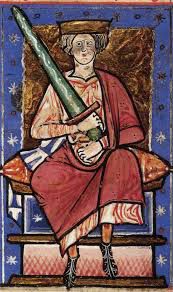
Emma of Normandy was the daughter of Richard the Fearless. She was a Norman-born nobles woman who became the Queen through her marriage to the Anglo-Saxon King. She was the Queen of the English during her marriage to Ælthered from 1002-1016. Ælthered died in 1016, and Emma remarried King Sweyn’s son Cnut. As Cnut’s wife, she was Queen of England because of their marriage in 1017, Queen of Denmark from 1018, and Queen of Norway from 1028 until Cnut died in 1035.
To improve his standing with the English cause, the House of Normandy lacked the necessary political ties to support its influence. Her father, Richard I, Duke of Normandy, arranged a marriage between Emma and King Æthelred so they could unite together against a common enemy and also help boost his reputation.
At that time, England was under the constant threat of invasion forces from France. The lack of a staunch response made the people call King Æthelred’ the unready’, and he hoped his marriage to the House of Normandy would ease the attacks.
The Political match was made for Emma to marry King Æthelred, who was 20 years older than she was and had already fathered ten children from his first wife, Aelfgifu. Emma did this submissively and crossed the channel to produce English Norman offsprings and strengthen the position of her household.
Emma arrived in England just at the age of 12 and proceeded to establish herself in the day-to-day dealings of Aethelred’s court, gaining respect amongst Anglo-Saxons who had initially been wary of her.
King Æthelred, eager to expel all Danes, orchestrated the St. Brice’s day massacre. The massacre claimed the lives of famous Danes like Gunhilde, the sister of Denmark’s King Sweyn I, on the outskirts of Northern England.
Queen Emma, who was focused on producing offspring, gave birth to Edward the Confessor around 1003, with a second son named Alfred Aetheling and a daughter named Godgifu to follow. Aethelred gave her vast land and properties in Winchester, Devonshire, Oxfordshire, Exeter, Suffolk, and Rutland. She set about establishing herself through building and exploiting the benefits of no taxation her husband had afforded her. However, growing tensions now obliterated her luxurious new life.
The rage and subsequent Viking Invasion in the 11th century by King Sweyn resulted in Emma’s fleeing to Normandy under the protection of her father. Aethelred also managed to evade capture and eventually established residence on the Isle of Wight. While King Sweyn established his kingdom in England with his sons Cnut and Harold, as would be, King Sweyn died in 1014, which brought back the return of Æthelred and Emma.
However, Æthelred died in 1016, and Emma’s future was thrown into doubt. She was barely 30 when Æthelred died, and to secure her place, she got married to the Danish King Cnut the Great, the man who stole the crown of Æthelred. Her marriage to Cynut produced two children, Harthacnut and Gunhilda.
Her marriage to Cnut helped her grow her affluence, and at a time, women were only seen as caregivers; her achievements in politics, religious order and Norman English relations became historic.
